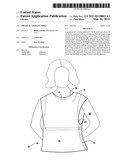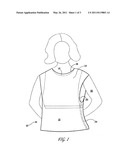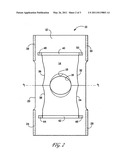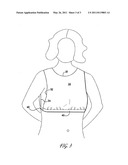Patent application title: Physical therapy shirt
Inventors:
Denise Giroux (Marshfield, MA, US)
IPC8 Class: AA41B906FI
USPC Class:
2113
Class name: Body garments shirts undergarments
Publication date: 2011-05-26
Patent application number: 20110119803
Abstract:
A garment for women adapted to be donned and removed easily by a person
without assistance. Said garment being formed of an outer cloth shirt and
an inner cloth camisole; wherein both the shirt and the camisole are
formed from substantially rectangularly shaped cloth sheets, the longer
sides being recessed centrally thereof to form arm openings. The lower
ends of the longer sides of the outer shirt being each provided with
releasable fastening means and the shorter sides of the camisole having
elastic strips attached thereto at the ends thereof, and the ends of the
elastic strips being each provided with releasable fastening means. Both
of the cloth sheets having head openings located centrally thereof.Claims:
1. A physical therapy shirt consisting of an outer cloth shirt and an
inner cloth camisole; wherein both the shirt and the camisole are formed
with open sides which are closable along at least a portion of their
sides by releasable fastening means.
2. The physical therapy shirt of claim 1 wherein the camisole consists of front and rear panels which have bottom edges which carry releasable fastening means located at the bottom of such panels.
3. The physical therapy shirt of claim 2 wherein the bottom edges of the camisole have elastic strips attached thereto, to the ends of which are the affixed the edges carrying the releasable fastening means.
4. The physical therapy shirt of claim 1 wherein the outer cloth shirt and the inner cloth camisole have head openings which are concentric with one another, the head opening of the shirt being smaller in diameter than the head opening of the camisole.
5. The physical therapy shirt of claim 4 wherein the camisole is stitched to the outer shirt with the head openings in the camisole and the shirt being aligned to be concentric with one another.
6. A camisole consisting of a substantially rectangular cloth sheet having a generally circular opening located centrally thereof, the shorter sides thereof having elastic strips attached thereto, both ends of said strips having releasable fastening means extending therefrom.
7. The camisole of claim 6 wherein the longer sides are recessed so as to provide unobstructed arm openings when the camisole is worn.
8. The camisole of claim 7 wherein a substantially rectangular outer cloth shirt longer and wider than the camisole is stitched to the camisole along an axis located centrally and substantially perpendicular to the longer sides of the camisole.
9. The camisole of claim 8 wherein the longer sides of the outer cloth shirt are recessed so as to provide unobstructed arm openings which are aligned with the openings in the sides of the camisole.
10. The camisole of claim 9 wherein the ends of the longer sides of the outer cloth shirt are provided with releasable fastening means.
Description:
FIELD OF THE INVENTION
[0001] The present invention relates to specialized clothing, and is more particularly concerned with providing a functional shirt for women who have had shoulder surgery and will attend physical rehabilitation.
BACKGROUND OF THE INVENTION
[0002] Many women, after experiencing shoulder surgery, find it difficult to put on a shirt since their arm is immobilized and they have to straighten the arm to put it through a shirt sleeve. Also, women find it far too painful to wear a bra after such surgery.
[0003] Since physical therapy is generally prescribed after such surgery, it becomes awkward to undergo such therapy without a bra, especially if the therapist is male. It is therefore desirable to provide a shirt that can be put on by simply pulling it over the head of the wearer with the undisturbed arm and then be able to fasten the shirt in place. Also, the shirt should be so constructed as to eliminate the necessity for bra straps and the resulting pain in fastening the shirt to the chest size of the wearer.
[0004] A garment adapted for wear by physically handicapped persons who are incapable of executing dressing movements is shown in U.S. Pat. No. 4,258,440 issued to Malissa McGowan on Mar. 31, 1981. The garment comprises a front and rear panel such as front panel 36 and rear panel 38 of the shirt shown in FIG. 4. Each panel has opposed side edge margins having fastening means such as Velcro® or other type of fastening device 42 secured to those edge margins 44, which when pressed together will effect engagement of the fasteners to couple the edges together. The wearer can draw the panels together. However, the shirt shown has sleeves which would inhibit a wearer whose arm is in a sling or otherwise immobilized. Additionally, no means are suggested which would alleviate the pain associated with wearing a bra after undergoing shoulder surgery.
[0005] Garments for physically challenged persons have also been provided previously such as shown in U.S. Pat. No. 5,564,123, issued to Betty Grassick on Oct. 15, 1996. Grassick shows a single piece garment 10 formed of one or more sheets or sections of material in which all openings are separable along at least one seam thereof. The garment may be placed against the back of a person and wrapped around the person and closed along a seam such as seam 24. The shoulders and sleeves may also be wrapped around the arms and closed to provide a garment The closure of the garment is accomplished by means of hook and loop fastening material such as Velcro®. The garment of the present invention is also assembled around a person by means of fasteners of this type, however no means are found in Grassick that address the need for alleviating the pain associated with wearing a bra after undergoing shoulder surgery.
[0006] Another shirt garment for use in conjunction with medical procedures is shown in U.S. Pat. No. 6,115,840 issued to Warren C. Hastings on Sep. 12, 2000. The shirt shown in that patent is to be worn by patients who are fitted with a "halo" apparatus. The upper part of the shirt includes front, back right and left flaps which may be attached by releasable fastening elements to form an annular collar and right and left sleeves. Although designed for use as a medical access shirt to accommodate a halo device such shirt cannot be assembled by a patient who has undergone shoulder surgery and has their arm immobilized. Also, no means are suggested that alleviate pain when wearing a bra after undergoing shoulder surgery.
[0007] Still another undershirt formed by having overlapped panels with re-sealable closure means is shown in U.S. Pat. No. 6,240,563 issued to William P. Niedermeyer on Jun. 5, 2001. In FIG. 21 a rear panel 117 is formed by folding along line F3-F3' and this is joined to front panel 118 by folding front panel flaps 119, 120 along side lines F1-F1' and F2-F2' to form a shirt as shown in FIG. 22. However, again, no means are provided which address the issue of alleviating pain when wearing a bra after undergoing shoulder surgery.
SUMMARY OF THE INVENTION
[0008] The invention herein described is in the nature of an improvement over the prior art devices. It is therefore one object of the invention to provide a shirt for post-operative use after shoulder surgery wherein the affected arm is immobilized. The shirt is so constructed as to eliminate having to straighten or lift the immobilized arm to put it through a shirt sleeve.
[0009] Another object of the invention is to provide a shirt for post-operative use after shoulder surgery wherein a means is provided for eliminating the necessity of wearing a bra, eliminating bra straps and the attendant pain associated with fastening a bra.
[0010] A still further object of the invention is to provide a functional shirt for women who have had shoulder surgery and will attend rehabilitation. The shirt allows for easy manipulation of the arm while undergoing physical therapy without having to remove any clothing.
BRIEF DESCRIPTION OF THE DRAWINGS
[0011] These and other objects and features of the present invention are more fully disclosed or rendered obvious by the following detailed description of a preferred embodiment, which is to be considered together with the accompanying drawings, wherein like numbers refer to like parts, and further wherein:
[0012] FIG. 1 is a perspective view of a woman wearing the shirt of the invention with the breast supporting camisole indicated in phantom;
[0013] FIG. 2 is a plan view of the shirt of the invention showing the breast supporting camisole positioned in relationship to the shirt; and
[0014] FIG. 3 is a perspective view of a woman wearing the camisole shown detached from the shirt which has been correctly fastened to provide support for the breasts.
DETAILED DESCRIPTION OF THE INVENTION
[0015] A preferred embodiment of the physical therapy shirt is shown in FIG. 1 wherein a post operative shirt 10 is shown on a wearer and consists of an outer cloth shirt 12 and an inner cloth camisole 14 (shown in phantom). In the preferred embodiment the camisole 14 is joined to the outer shirt 12 by stitching along line L1-L1 as shown in FIG. 2.
[0016] As shown in FIG. 2 the outer shirt 12 has a head opening 16 which is concentric with the head opening 18 in the camisole 14. The openings are so shaped that when the therapy shirt is worn, the camisole is not visible (see FIG. 1). The edges of the outer shirt are cut away as at 20 and 22 in order to form sleeve openings. One edge of the outer shirt 12 is extended at 24 and 26 to provided fastening tabs. When the tabs are fastened to one another after the shirt is put on by the wearer one arm opening is completely formed. Similarly, the other edge of the outer shirt are provided with extending tabs 28 and 30 which can be reclosably fastened to one another to completely form another arm opening. The tabs 24 and 26 as well as the tabs 28 and 30 can be fastened to one another by well known closure means such as interlocking male/female loop strips like Velcro® or Ziplock®.
[0017] FIG. 1 shows a completely assembled outer shirt 12 being worn by a person after it is placed over their head and the tabs 24, 26 and 28,30 are fastened to one another. Although not so shown, the arm 32 will be immobilized if the shoulder has been operated upon. In that event the garment can be assembled by using the other arm and hand to draw the tabs 24 and 26 towards one another and fasten them together.
[0018] In the preferred embodiment, the camisole 14 is centrally located and stitched in place as shown in FIG. 2. The sides of the camisole are relieved as shown at 32, 34 to form a one arm opening; and another arm opening is formed by the relieved sides 36, 38 when the camisole is assembled on the wearer. The lower ends of the camisole are provided with elastic bands 40 and 42. Extending outwardly from the ends of the bands are tabs 44, 46, 48 and 50 which are each provided with closure means such as interlocking male/female loop strips.
[0019] When the shirt 10 is placed over the head of the wearer, first the front and back of the camisole are joined by fastening the tab 44 to tab 46 and fastening the tab 48 to tab 50. Because of the elasticity of the strips 40, 42 the camisole can be drawn tightly to fit the wearer by stretching the elastic strips 40 and 42 and positioning the tabs 44, 46 and 48,50 and to cover the breasts. The wearing of a bra is thus made unnecessary. Following that, the front and back of the outer shirt 12 are joined to one another by fastening the tabs 26 and 30 to 24 and 28, respectively.
[0020] In this manner the wearer is enabled to put on and assemble the shirt without requiring the help of an attendant and also has the freedom to undergo physical therapy while retaining a degree of modesty.
[0021] Various modifications may be made in the physical therapy shirt such as not employing stitching to join the outer shirt and the camisole. Thus, the camisole can be separate from the outer shirt 12 and worn separately as shown in FIG. 3.
[0022] These and other changes are all considered to be within the spirit and scope of the present invention.
User Contributions:
Comment about this patent or add new information about this topic:
| People who visited this patent also read: | |
| Patent application number | Title |
|---|---|
| 20110123375 | ROTATIONAL DIRECTION INDICATOR |
| 20110123374 | COMPENSATOR ASSEMBLY FOR SUBMERSIBLE PUMP SYSTEM |
| 20110123373 | REFRIGERANT COMPRESSOR |
| 20110123371 | VANE PUMP AND EVAPORATIVE LEAK CHECK SYSTEM HAVING THE SAME |
| 20110123370 | ELECTRIC WATER PUMP |




